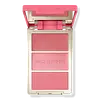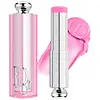What's inside
What's inside
 Key Ingredients
Key Ingredients

 Benefits
Benefits

 Concerns
Concerns

 Ingredients Side-by-side
Ingredients Side-by-side

Phenyl Trimethicone
Skin ConditioningTriisostearyl Citrate
EmollientPPG-3 Benzyl Ether Myristate
EmollientSynthetic Wax
AbrasiveDipentaerythrityl Hexahydroxystearate/Hexastearate/Hexarosinate
Skin ConditioningMica
Cosmetic ColorantDiisostearyl Malate
EmollientVinyl Dimethicone/Methicone Silsesquioxane Crosspolymer
Ethylhexyl Palmitate
EmollientEthylhexyl Stearate
EmollientSilica
AbrasivePolybutene
Disteardimonium Hectorite
StabilisingOctyldodecanol
EmollientPhenoxyethanol
PreservativePropylene Carbonate
SolventEthylhexylglycerin
Skin ConditioningPentaerythrityl Tetra-Di-T-Butyl Hydroxyhydrocinnamate
AntioxidantWater
Skin ConditioningButylene Glycol
HumectantDioscorea Opposita Root Extract
Skin ConditioningKaolin
AbrasiveTin Oxide
AbrasiveCI 77891
Cosmetic ColorantCI 15850
Cosmetic ColorantCI 45410
Cosmetic ColorantCI 42090
Cosmetic ColorantIron Oxides
Datem
EmollientMaltodextrin
AbsorbentCI 19140
Cosmetic ColorantCI 75470
Cosmetic ColorantCaprylic/Capric Triglyceride
MaskingSynthetic Fluorphlogopite
Simmondsia Chinensis Seed Oil
EmollientSynthetic Beeswax
Emulsion StabilisingCalcium Aluminum Borosilicate
Helianthus Annuus Seed Wax
Skin ConditioningDicaprylyl Carbonate
EmollientSorbitan Isostearate
EmulsifyingGlyceryl Caprylate
EmollientStearalkonium Hectorite
Gel FormingVitis Vinifera Seed Oil
EmollientSorbitan Sesquioleate
EmulsifyingHelianthus Annuus Seed Oil
EmollientAluminum Hydroxide
EmollientMangifera Indica Seed Butter
Skin ConditioningButyrospermum Parkii Butter
Skin ConditioningTocopherol
AntioxidantCI 77492
Cosmetic ColorantCI 15985
Cosmetic ColorantCI 77491
Cosmetic ColorantPEG-12 Dimethicone
Skin ConditioningMagnesium Myristate
Magnesium Stearate
Cosmetic ColorantPolymethylsilsesquioxane
Squalane
EmollientTocopheryl Acetate
AntioxidantHydrolyzed Silk
HumectantCaprylyl Glycol
EmollientTriethoxycaprylylsilane
Synthetic Ruby Powder
AbrasiveCI 77499
Cosmetic ColorantCI 77007
Cosmetic ColorantPhenyl Trimethicone, Triisostearyl Citrate, PPG-3 Benzyl Ether Myristate, Synthetic Wax, Dipentaerythrityl Hexahydroxystearate/Hexastearate/Hexarosinate, Mica, Diisostearyl Malate, Vinyl Dimethicone/Methicone Silsesquioxane Crosspolymer, Ethylhexyl Palmitate, Ethylhexyl Stearate, Silica, Polybutene, Disteardimonium Hectorite, Octyldodecanol, Phenoxyethanol, Propylene Carbonate, Ethylhexylglycerin, Pentaerythrityl Tetra-Di-T-Butyl Hydroxyhydrocinnamate, Water, Butylene Glycol, Dioscorea Opposita Root Extract, Kaolin, Tin Oxide, CI 77891, CI 15850, CI 45410, CI 42090, Iron Oxides, Datem, Maltodextrin, CI 19140, CI 75470, Caprylic/Capric Triglyceride, Synthetic Fluorphlogopite, Simmondsia Chinensis Seed Oil, Synthetic Beeswax, Calcium Aluminum Borosilicate, Helianthus Annuus Seed Wax, Dicaprylyl Carbonate, Sorbitan Isostearate, Glyceryl Caprylate, Stearalkonium Hectorite, Vitis Vinifera Seed Oil, Sorbitan Sesquioleate, Helianthus Annuus Seed Oil, Aluminum Hydroxide, Mangifera Indica Seed Butter, Butyrospermum Parkii Butter, Tocopherol, CI 77492, CI 15985, CI 77491, PEG-12 Dimethicone, Magnesium Myristate, Magnesium Stearate, Polymethylsilsesquioxane, Squalane, Tocopheryl Acetate, Hydrolyzed Silk, Caprylyl Glycol, Triethoxycaprylylsilane, Synthetic Ruby Powder, CI 77499, CI 77007
Polyglyceryl-2 Triisostearate
EmulsifyingSqualane
EmollientHydrogenated Polydecene
EmollientDimer Dilinoleyl Dimer Dilinoleate
EmollientHelianthus Annuus Seed Wax
Skin ConditioningMica
Cosmetic ColorantCera Alba
EmollientTrimethylolpropane Triisostearate
EmollientCopernicia Cerifera Wax
Diisostearyl Malate
EmollientParfum
MaskingEthyl Vanillin
MaskingPrunus Avium Seed Oil
EmollientPentaerythrityl Tetra-Di-T-Butyl Hydroxyhydrocinnamate
AntioxidantMenthol
MaskingVanillin
MaskingAluminum Hydroxide
EmollientMentha Piperita Oil
MaskingPropyl Gallate
AntioxidantCI 77891
Cosmetic ColorantCI 45410
Cosmetic ColorantCI 15850
Cosmetic ColorantPolyglyceryl-2 Triisostearate, Squalane, Hydrogenated Polydecene, Dimer Dilinoleyl Dimer Dilinoleate, Helianthus Annuus Seed Wax, Mica, Cera Alba, Trimethylolpropane Triisostearate, Copernicia Cerifera Wax, Diisostearyl Malate, Parfum, Ethyl Vanillin, Prunus Avium Seed Oil, Pentaerythrityl Tetra-Di-T-Butyl Hydroxyhydrocinnamate, Menthol, Vanillin, Aluminum Hydroxide, Mentha Piperita Oil, Propyl Gallate, CI 77891, CI 45410, CI 15850
Ingredients Explained
These ingredients are found in both products.
Ingredients higher up in an ingredient list are typically present in a larger amount.
Aluminum Hydroxide is a form of aluminum. It can be naturally found in nature as the mineral gibbsite. In cosmetics, Aluminum Hydroxide is used as a colorant, pH adjuster, and absorbent.
As a colorant, Aluminum Hydroxide may add opacity, or reduce the transparency. Aluminum hydroxide is contains both basic and acidic properties.
According to manufacturers, this ingredient is an emollient and humectant. This means it helps hydrate the skin.
In medicine, this ingredient is used to help relieve heartburn and help heal ulcers.
There is currently no credible scientific evidence linking aluminum hydroxide in cosmetics to increased cancer risk.
Major health organizations allow the use of aluminum hydroxide in personal care products and have not flagged it as a carcinogenic risk at typical usage levels.
Learn more about Aluminum HydroxideCi 15850 is the pigment color red. It is an azo dye and created synthetically.
Azo dyes need to be thoroughly purified before use. This allows them to be more stable and longer-lasting.
This ingredient is common in foundations, lipsticks, and blushes. This color is described as brown/orangey red.
It has many secondary names such as Red 6 and Red 7. According to a manufacturer, Red 6 usually contains aluminum.
Learn more about CI 15850CI 45410 is a synthetic red-pigment and dye.
It often goes by both Red 28 or Red 27; manufacturers label both ingredients as CI 45410.
This dye is commonly found in makeup because it imparts a vivid color. Some types of this dye change color based on pH level and interaction with moisture:
Your skin has a natural pH of around 4.5 - 5.5.
According to the FDA, CI 45410 is not permitted for use in eye products.
Red 27 is a flourescein dye and commonly used as a fluorescent tracer in medicine.
Learn more about CI 45410Ci 77891 is a white pigment from Titanium dioxide. It is naturally found in minerals such as rutile and ilmenite.
It's main function is to add a white color to cosmetics. It can also be mixed with other colors to create different shades.
Ci 77891 is commonly found in sunscreens due to its ability to block UV rays.
Learn more about CI 77891Diisostearyl Malate is an emollient and most often used in lip products. It comes from isostearyl alcohol, a fatty acid, and malic acid, an AHA.
As an emollient, Diisostearyl Malate helps create a thin film on your skin to trap moisture in. This helps keep your skin soft and smooth.
Helianthus Annuus Seed Wax is created from the common sunflower.
Sunflower seed wax is made up of long chain non-glyceride esters, a small amount of fatty alcohols, and fatty acids.
This ingredient is often used to enhance the texture of products. The fatty acid properties also help hydrate the skin.
Learn more about Helianthus Annuus Seed WaxMica is a naturally occurring mineral used to add shimmer and color in cosmetics. It can also help improve the texture of a product or give it an opaque, white/silver color.
Serecite is the name for very fine but ragged grains of mica.
This ingredient is often coated with metal oxides like titanium dioxide. Trace amounts of heavy metals may be found in mica, but these metals are not harmful in our personal products.
Mica has been used since prehistoric times throughout the world. Ancient Egyptian, Indian, Greek, Roman, Aztec, and Chinese civilizations have used mica.
Learn more about MicaPentaerythrityl Tetra-Di-T-Butyl Hydroxyhydrocinnamate (long name, huh?) is a synthetic antioxidant.
It is used to help stabilize other antioxidants or prevent the color from changing in a product.
As an antioxidant, it helps fight free-radical molecules. Free-radical molecules are capable of damaging our cells and other genetic material. Thus, antioxidants may reduce the signs of aging.
This ingredient is oil-soluble.
Learn more about Pentaerythrityl Tetra-Di-T-Butyl HydroxyhydrocinnamateSqualane is an emollient that helps the skin hold onto moisture. It's an oily liquid that occurs naturally in certain types of fish and plant oils.
Because squalane boosts hydration in the skin, it also comes with plenty of benefits: it is an antioxidant and can help fight free radicals and skin damage. Squalane is also found to have a detoxifying effect when applied.
Squalane comes from squalene, which occurs naturally within the sebum of our skin. It is one of the oils our skin produces to keep itself hydrated. Squalane is the hydrogenated version of squalene and has a longer shelf life.
Research shows that squalane is non-irritating (even at 100% concentration).
In general, it's a fantastic ingredient. It does a great job at hydrating the skin, and it's suitable for those with sensitive skin.
The source of squalane may impact malassezia / fungal acne. This is because olive oil derived squalane can contain impurities such as fatty acids and plant waxes. Sugarcane derived squalane is recommended for anyone with malassezia concerns.
Is squalane vegan?
This depends on the source. Squalane can be derived from both plants and animals. Most squalane used in skincare comes from plants.
Please note: the source of squalane is only known if disclosed by the brand. We recommend reaching out to the brand if you have any questions about their squalane.
Read more about squalene with an "e".
Is squalane an oil?
Squalane is often called an oil, but it’s technically not; it’s a hydrocarbon, meaning it’s only made of carbon and hydrogen, unlike true oils which are triglycerides made of fatty acids and glycerol.
The term “oil-free” isn’t regulated, so companies can define it however they want. Some exclude all oils, while others just avoid mineral oil or comedogenic oils.
While some people avoid oils thinking they cause breakouts, the right kind of oil (or oil-like ingredient like squalane) can actually help balance and hydrate your skin. It’s worth testing out simple oils or squalane to see what works best for your skin.
Learn more about Squalane